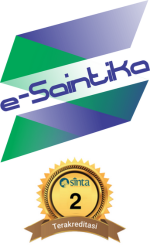Analysis of Mathematical Communication Skills of Grade X MA Students on the Material of Trigonometric Function Graphs Aided by Geogebrabook
Abstract
Keywords
References
Abidin, Z., Susanti, E., Faradiba, S. S., & Sunismi, S. (2023). Pelatihan Aplikasi GeoGebra pada Materi Persamaan Garis Lurus. PengabdianMu Jurnal Ilmiah Pengabdian Kepada Masyarakat, 8(3), 477–488. https://doi.org/10.33084/pengabdianmu.v8i3.4607
Aditya, R. S., & Sukestiyarno, Y. L. (2019). Kemampuan Komunikasi Matematis Siswa Ditinjau dari Self Concept Matematis pada Materi Trigonometri. https://proceeding.unnes.ac.id/snpasca/article/view/323
Aini, R. (2021). Kemampuan komunikasi matematis dalam proses pembelajaran matematika pada materi sistem persamaan linear dua variabel siswa kelas VIII SMP. JURNAL ISLAMIKA GRANADA, 1(2), 48–53. https://doi.org/10.51849/ig.v2i1.20
Akram, H., Abdelrady, A. H., Al-Adwan, A. S., & Ramzan, M. (2022). Teachers’ perceptions of technology integration in teaching-learning practices: A systematic review. Frontiers in psychology, 13. https://doi.org/10.3389/fpsyg.2022.920317
Anas, N. (2021). Komunikasi antara Kognitif dan Kemampuan Berbahasa. EUNOIA (Jurnal Pendidikan Bahasa Indonesia), 1(1). http://dx.doi.org/10.30821/eunoia.v1i1.997
Andriono, R. (2021). Analisis Peran Etnomatematika dalam Pembelajaran Matematika. ANARGYA Jurnal Ilmiah Pendidikan Matematika, 4(2). https://doi.org/10.24176/anargya.v4i2.6370
Asmana, A. T. (2022). ANALISIS KEMAMPUAN KOMUNIKASI MATEMATIS TULIS SISWA SMP DITINJAU DARI KECERDASAN INTERPERSONAL. www.ejournal.universitaspgridelta.ac.id. https://doi.org/10.51836/je.v8i1.338
Barus, M. D. B., & Hakim, A. (2020). Analisis kemampuan pemecahan masalah matematika melalui metode practice rehearsal pairs pada siswa SMA Al-Hidayah Medan. Biormatika : Jurnal Ilmiah Fakultas Keguruan Dan Ilmu Pendidikan, 6(1), 74–78. https://doi.org/10.35569/biormatika.v6i1.687.
Cholily, Y. M., Amalia, S., & Pr, A. A. (2024). STUDENT’S MATHEMATICAL COMMUNICATION ABILITY GIVEN SELF CONCEPT IN LEARNING MATHEMATICS THROUGH DISCOVERY LEARNING. Prima Jurnal Pendidikan Matematika, 8(1), 89. https://doi.org/10.31000/prima.v8i1.9902
Church, R. B., Perry, M., Singer, M. A., Cook, S. W., & Alibali, M. W. (2024). Teachers’ gestures and how they matter. Topics in cognitive science. https://doi.org/10.1111/tops.12755
Cook, S. C., Collins, L. W., Morin, L. L., & Riccomini, P. J. (2020). Schema-based instruction for mathematical word problem solving: An evidence-based review for students with learning disabilities. Learning Disability Quarterly, 43(2). https://doi.org/10.1177/0731948718823080
Dahal, N., Pant, B. P., Shrestha, I. M., & Manandhar, N. K. (2022). Use of GeoGebra in teaching and learning Geometric transformation in school mathematics. International Journal of Interactive Mobile Technologies (iJIM), 16(08), 65–78. https://doi.org/10.3991/ijim.v16i08.29575
Gal, I., Grotlüschen, A., Tout, D., & Kaiser, G. (2020). Numeracy, adult education, and vulnerable adults: a critical view of a neglected field. Zdm, 52. https://doi.org/10.1007/s11858-020-01155-9
Hwang, G. J., & Tu, Y. F. (2021). Roles and research trends of artificial intelligence in mathematics education: A bibliometric mapping analysis and systematic review. Mathematics, 9(6). https://doi.org/10.3390/math9060584
Kusumah, Y. S., Kustiawati, D., & Herman, T. (2020). The Effect of GeoGebra in Three-Dimensional Geometry Learning on Students’ Mathematical Communication Ability. International Journal of Instruction, 13(2), 895-908. https://doi.org/10.29333/iji.2020.13260a
Lutfi, A., & Elfitriadi, E. (2023). Kemampuan Komunikasi Matematis Siswa Tipe Kepribadian Sanguin (Percaya Diri) dalam Proses Pembelajaran Matematika. Andragogi Jurnal Diklat Teknis Pendidikan Dan Keagamaan, 11(1), 77–86. https://doi.org/10.36052/andragogi.v11i1.312
Naimah, N. H., Prasetyowati, D., & Rahmawati, N. D. (2022). Analisis Kemampuan Komunikasi Matematis Siswa SMA dalam Menyelesaikan Masalah Matematika pada Materi SPLTV Ditinjau dari Tipe Kepribadian Extravert dan Introvert. Imajiner Jurnal Matematika Dan Pendidikan Matematika, 4(4), 329–339. https://doi.org/10.26877/imajiner.v4i4.10233
Ningsih, A. A., Utami, C., & Wahyuni, R. (2020). Analisis kemampuan koneksi matematis siswa pada materi trigonometri. Journal of Educational Review and Research, 3(1), 6. https://doi.org/10.26737/jerr.v3i1.2015
Orhani, S. (2024). Addressing Students’ Challenges in Acquiring Trigonometric Function Concepts: A Didactic Approach to Education for Sustainable Development. Journal of Education for Sustainable Development Studies., 1(2), 160–172. https://doi.org/10.70232/jesds.v1i2.15
Pertiwi, E. D., Khabibah, S., & Budiarto, M. T. (2020). Komunikasi Matematika dalam Pemecahan Masalah. Jurnal Cendekia Jurnal Pendidikan Matematika, 4(1), 202–211. https://doi.org/10.31004/cendekia.v4i1.151
Pohan, D. D., & Fitria, U. S. (2021), Jenis Jenis Komunikasi. Cybernetics: Journal Educational Research and Social Studies, 2(3). https://pusdikra-publishing.com/index.php/jrss/article/view/158
Puspita, D. A., Anggoro, B. S., & Pratiwi, D. D. (2024). Riset Keterhubungan: Bagaimana Self-confidence dan Resiliensi Matematis Mempengaruhi Penalaran dan Kecerdasan Numerik Siswa. Kognitif Jurnal Riset HOTS Pendidikan Matematika, 4(3). https://doi.org/10.51574/kognitif.v4i3.2066
Siregar, R. N., Mujib, A., Siregar, H., & Karnasih, I. (2020). Peningkatan kemampuan berpikir kreatif siswa melalui pendekatan matematika realistik. Edumaspul - Jurnal Pendidikan, 4(1), 56–62. https://doi.org/10.33487/edumaspul.v4i1.338
Suhenda, L. L. A., & Munandar, D. R. (2023). Kemampuan komunikasi matematis siswa dalam pembelajaran matematika. Jurnal Educatio FKIP UNMA, 9(2), 1100–1107. https://doi.org/10.31949/educatio.v9i2.5049
Suryawati, S., Hasbi, M., Suri, M., & Kurniawati, S. (2023). FAKTOR YANG MEMPENGARUHI KEMAMPUAN KOMUNIKASI MATEMATIS SISWA SMP. JOURNAL OF EDUCATION SCIENCE, 9(1), 7. https://doi.org/10.33143/jes.v9i1.2849
Syahrizal, H., & Jailani, M. S. (2023). Jenis-Jenis Penelitian Dalam Penelitian Kuantitatif dan Kualitatif. Jurnal QOSIM Jurnal Pendidikan Sosial & Humaniora, 1(1), 13–23. https://doi.org/10.61104/jq.v1i1.49
Vinsensia, D. ., Utami, Y. ., Lubis, R. K. ., Panggabean, E. ., Amala, D. N. ., & Sianturi, A. N. . (2024). Pelatihan Software Matematika Geogebra Sebagai Media Pembelajaran Berbasis Teknologi. Jurnal Pengabdian Kepada Masyarakat Nusantara, 5(3), 3475- 3481. https://doi.org/10.55338/jpkmn.v5i3.3759
Yusanto, Y. (2020). Ragam pendekatan penelitian kualitatif. JOURNAL OF SCIENTIFIC COMMUNICATION (JSC), 1(1). https://doi.org/10.31506/jsc.v1i1.7764
Yusoff, N. a. S. M., Durairaj, N. K., Mohamed, N. R., Peng, N. F. S., Abdullah, N. N., Ismail, N. H., Salleh, N. S. M., & Wahid, N. Z. (2022). Communication in Mathematics among School Children: A Systematic review. Journal of Advanced Research in Applied Sciences and Engineering Technology, 28(2), 275–290. https://doi.org/10.37934/araset.28.2.275290
Yustiani, N. R., & Nasution, S. H. (2022). Pengembangan Lembar Kegiatan Siswa Berbasis Online Berbantuan Geogebra Book untuk Siswa SMA Kelas X pada Materi Trigonometri. EDUMAT Jurnal Edukasi Matematika, 12(2), 65–79. https://doi.org/10.53717/edumat.v12i2.288
Zhou, H., Gu, B., Zou, X., Li, Y., Chen, S. S., Zhou, P., Liu, J., Hua, Y., Mao, C., Wu, X., Li, Z., & Liu, F. (2023). A survey of large language models in Medicine: principles, applications, and challenges. arXiv (Cornell University). https://doi.org/10.48550/arxiv.2311.05112
Ziatdinov, R., & Valles Jr, J. R. (2022). Synthesis of modeling, visualization, and programming in GeoGebra as an effective approach for teaching and learning STEM topics. Mathematics, 10(3). https://doi.org/10.3390/math10030398
DOI: https://doi.org/10.33394/j-ps.v13i3.15489
Refbacks
- There are currently no refbacks.
Copyright (c) 2025 Novita Rizki Yustiani, Alfiani Athma Putri Rosyadi, Yus Mochamad Cholily

This work is licensed under a Creative Commons Attribution 4.0 International License.

J-PS (Prisma Sains: Jurnal Pengkajian Ilmu dan Pembelajaran Matematika dan IPA IKIP Mataram) p-ISSN (print) 2338-4530, e-ISSN (online) 2540-7899 is licensed under a Creative Commons Attribution 4.0 International License.









 https://orcid.org/0000-0003-4395-5221
https://orcid.org/0000-0003-4395-5221